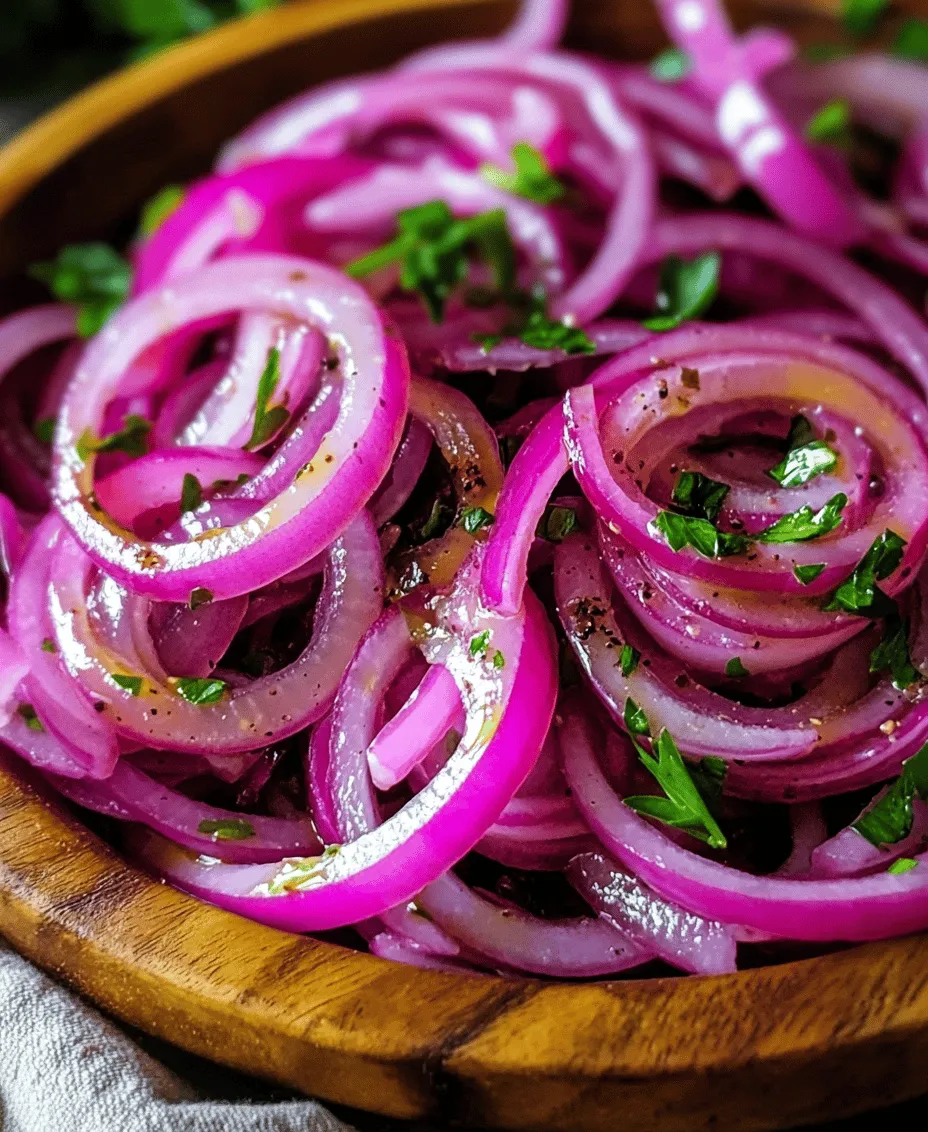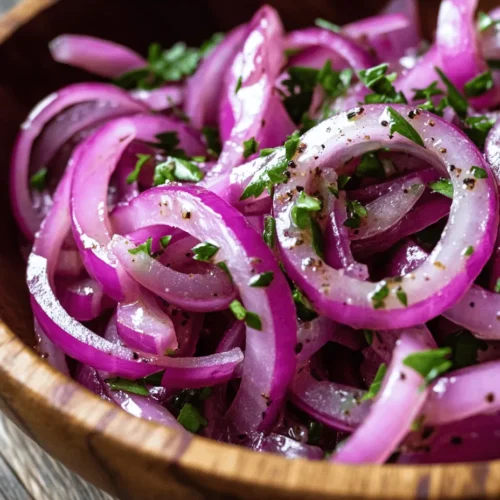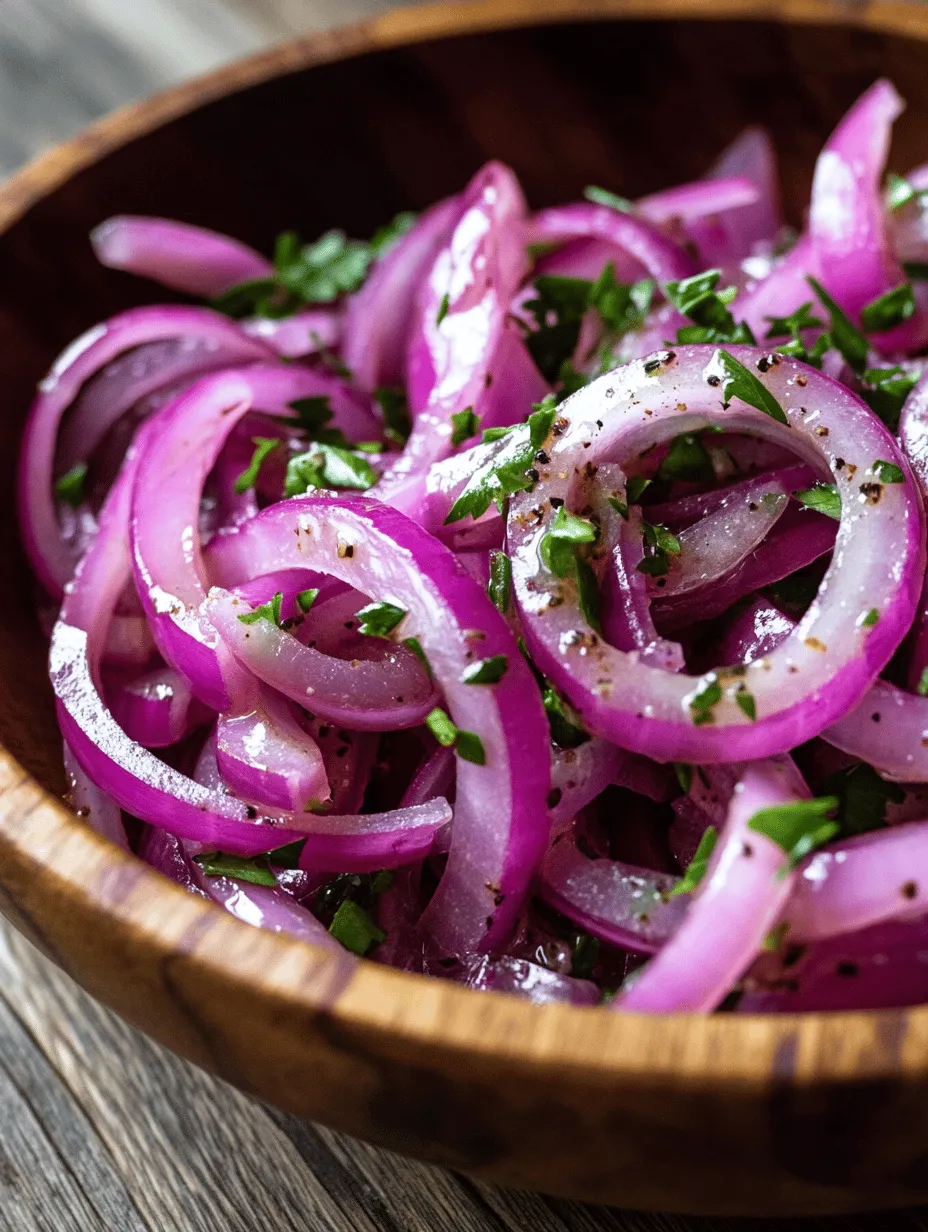Introduction to Sumac Onions Delight
Sumac Onions Delight is a vibrant and tangy dish that transcends cultural boundaries, making it a beloved addition to various cuisines worldwide. Known for its refreshing flavor profile, this dish combines the sharpness of red onions with the unique tartness of sumac, resulting in a delightful accompaniment to a range of meals. Often featured in Middle Eastern and Mediterranean dishes, Sumac Onions Delight is not only a feast for the taste buds but also a healthy choice for those looking to elevate their culinary repertoire.
The star ingredient, sumac, is a spice that has been used for centuries in traditional cooking. Its bright red color and tangy flavor can add depth to any dish, while also offering numerous health benefits. Sumac is rich in antioxidants, known for its anti-inflammatory properties, and it can aid in digestion. This makes it not just a flavor enhancer but also a nutritious addition to your meals.
Onions, particularly red onions, are another key component of this dish. They are renowned not only for their sharp, slightly sweet flavor but also for their versatility in cooking. From salads to salsas, onions are a staple in kitchens across the globe. They are packed with vitamins, minerals, and antioxidants, making them not only delicious but also beneficial for health. The combination of onions and sumac creates a harmonious balance of flavors that can elevate any meal, making Sumac Onions Delight a must-try recipe.
Understanding the Ingredients of Sumac Onions Delight
Red Onions: Flavor, Texture, and Nutritional Value
Red onions are the variety of choice for this dish due to their robust flavor and appealing color. They are milder than yellow onions and possess a sweet, slightly spicy taste that becomes even more pronounced when marinated. The texture of red onions is crisp and crunchy, which adds a delightful contrast to softer foods. Nutritionally, red onions are a powerhouse; they are low in calories yet high in vitamins C and B6, manganese, and dietary fiber. They also contain quercetin, a potent antioxidant that supports heart health and may have anti-cancer properties.
Sumac: Origins, Flavor Characteristics, and Culinary Uses
Sumac is a spice derived from the dried and ground berries of the sumac plant, which is native to the Mediterranean region and parts of the Middle East. The flavor of sumac is often described as tangy and lemony, providing a refreshing acidity that can brighten up dishes. It is commonly used in Middle Eastern cuisine, sprinkled over salads, grilled meats, and rice dishes to enhance the overall flavor profile. Beyond its culinary uses, sumac has a rich history as a medicinal herb, with traditional uses including treatment for various ailments due to its anti-inflammatory and antioxidant properties.
Olive Oil: Enhancing Flavor and Health Benefits
A key ingredient in Sumac Onions Delight is olive oil, which serves to enhance the flavors of the dish while also providing health benefits. Olive oil is rich in monounsaturated fats, which are heart-healthy and can lower bad cholesterol levels. Its smooth, fruity flavor complements the sharpness of the onions and the tartness of the sumac. When using high-quality extra virgin olive oil, not only do you add flavor, but you also enrich the dish with antioxidants and anti-inflammatory compounds.
Apple Cider Vinegar vs. Lemon Juice: Taste Differences and Health Benefits
In this recipe, you have the option to use either apple cider vinegar or lemon juice, both of which contribute acidity but have distinct flavor profiles. Apple cider vinegar offers a slightly sweet and fruity taste, while lemon juice adds a bright, zesty flavor. Both options bring health benefits to the table—apple cider vinegar is known for its potential to aid digestion and regulate blood sugar levels, while lemon juice is rich in vitamin C and can boost the immune system. Choosing between the two often depends on personal preference and the desired flavor profile of the dish.
Honey or Maple Syrup: Flavor Impact and Usage
The addition of honey or maple syrup in Sumac Onions Delight can provide a touch of sweetness to balance the tanginess of the sumac and the sharpness of the onions. Honey lends a floral sweetness, while maple syrup provides a deeper, more complex flavor. When deciding which to use, consider the overall flavor you wish to achieve. Both sweeteners can enhance the dish’s complexity and make it more appealing to a broader audience, especially if you are serving it alongside savory or spicy dishes.
The Role of Salt in Seasoning
Salt is an essential ingredient for seasoning, and its role in Sumac Onions Delight cannot be overstated. It acts to enhance the flavors of the other ingredients, bringing out their natural sweetness and balancing acidity. Proper salting is critical; too little can leave the dish flat, while too much can overpower the delicate flavors of the onions and sumac. A sprinkle of salt not only boosts flavor but also helps draw out moisture from the onions, allowing them to marinate and absorb the flavors of the other ingredients effectively.
Fresh Herbs: Garnishes that Elevate the Dish
Finally, the use of fresh herbs like parsley or cilantro not only adds a pop of color but also provides a fresh, aromatic element that brightens the dish. Fresh herbs can enhance the overall flavor and add additional nutrients, making the dish more vibrant and appealing. When selecting herbs, consider your personal preference and the flavors you enjoy. Parsley offers a mild, slightly peppery flavor, while cilantro adds a distinct citrusy note that can complement the sumac beautifully.
Step-by-Step Instructions for Preparing Sumac Onions Delight
Peeling and Slicing Red Onions
To begin preparing Sumac Onions Delight, the first step is to peel and slice the red onions. Start by cutting off the ends of each onion, then slice through the center to easily remove the skin. Once peeled, place the onion halves flat on the cutting board, and slice them thinly into half-moons. The thinner the slices, the more they will absorb the marinade and flavor, creating a more harmonious dish. Aim for uniform slices to ensure even marination and texture.
Marination: Essential for Flavor Development
Marination is a critical step in preparing Sumac Onions Delight. Once the onions are sliced, place them in a mixing bowl and sprinkle them generously with salt. Allow the onions to sit for about 10-15 minutes; this will help draw out excess moisture and soften the onions. After this initial resting period, you’re ready to add the other ingredients. The marination process allows the onions to absorb the flavors of sumac, olive oil, and vinegar or lemon juice, creating a complex and delicious dish.
Combining Ingredients for Optimal Results
After the onions have marinated, it’s time to add the remaining ingredients. Drizzle the sliced onions with high-quality olive oil and your choice of either apple cider vinegar or lemon juice. Sprinkle in the sumac, and if you’re using honey or maple syrup, add it at this stage as well. Gently toss the ingredients together, ensuring the onions are evenly coated with the oil and acidic components. This step is crucial, as it allows the sumac and other flavors to permeate through the onions, creating a rich and flavorful dish.
Tasting and Adjusting Seasonings
Before serving, it’s essential to taste the Sumac Onions Delight and adjust the seasonings as needed. You may want to add more salt, sumac, or a touch more sweetness, depending on your personal taste preferences. Remember that the flavors will continue to develop as the dish sits, so allowing it to marinate for at least an hour before serving will enhance the overall flavor profile.
Serving Suggestions for Sumac Onions Delight
Sumac Onions Delight can be served in various ways, making it a versatile addition to your dining table. As a side dish, it pairs beautifully with grilled meats, roasted vegetables, or as part of a mezze platter. It can also be used as a topping for flatbreads, mixed into salads, or served alongside rice dishes for a burst of flavor. The tangy and sweet notes of the dish complement a wide array of cuisines, making it a perfect accompaniment to your favorite meals.
As we move forward to the next part of this article, we will delve into some innovative serving suggestions and explore creative ways to incorporate Sumac Onions Delight into your culinary creations. Stay tuned for the continuation of this flavorful journey!

Suggestions for Using Sumac Onions Delight
Sumac onions delight is a versatile condiment that elevates various dishes with its tangy flavor and vibrant colors. This dish can be used creatively in many culinary contexts, making it an essential addition to your kitchen repertoire.
Topping for Grilled Meats and Salads
One of the most popular uses for sumac onions is as a topping for grilled meats. The tanginess of the sumac perfectly complements the rich flavors of grilled lamb, chicken, or beef. Simply spoon the sumac onions over your grilled meat just before serving for an added burst of flavor and a refreshing contrast to the smoky char.
In salads, sumac onions can serve as a zesty element that brightens up a simple greens salad or adds depth to a grain-based salad like tabbouleh or quinoa salad. Mix sumac onions into your favorite salad dressing or sprinkle them on top as a finishing touch to enhance the overall taste and presentation of your dish.
Creative Ways to Incorporate Sumac Onions into Wraps or Sandwiches
Wraps and sandwiches are another excellent avenue to explore when it comes to sumac onions. Their unique flavor can transform a basic sandwich into a gourmet experience. Try adding sumac onions to a classic chicken shawarma wrap, where the onions will add a fresh crunch and tanginess that balances the savory meat and creamy sauces.
For vegetarian options, consider layering sumac onions into a Mediterranean-inspired wrap with hummus, roasted vegetables, and fresh greens. The acidity from the sumac onions will help cut through the richness of the hummus while providing a refreshing burst of flavor.
Nutritional Benefits of Sumac Onions Delight
Not only is sumac onions delight delicious, but it also boasts numerous health benefits, making it a nutritious addition to your meals.
Overview of the Health Benefits Associated with Onions and Sumac
Onions are a powerhouse of nutrients, rich in vitamins C and B6, manganese, and dietary fiber. They contain antioxidants that help combat inflammation and support overall health. The sulfur compounds found in onions have been linked to heart health, as they may help lower blood pressure and cholesterol levels.
Sumac, on the other hand, is celebrated for its antioxidant properties. It contains compounds that can help neutralize free radicals in the body, potentially reducing the risk of chronic diseases. Additionally, sumac has been used in traditional medicine for its anti-inflammatory and antimicrobial properties.
Discussion on the Antioxidant Properties of Sumac and its Potential Health Benefits
The primary antioxidant in sumac is quercetin, which has been studied for its potential to reduce the risk of heart disease and cancer. Its anti-inflammatory properties may also contribute to better joint health and improved recovery after physical activity. Including sumac in your diet can help you harness these benefits while adding a unique flavor to your dishes.
The Role of Olive Oil in a Healthy Diet and its Heart-Healthy Fats
Olive oil, often used in conjunction with sumac onions, is another ingredient that enhances the health profile of this dish. Rich in monounsaturated fats, olive oil is known for its heart-healthy benefits. It can help reduce inflammation, lower bad cholesterol levels, and improve overall heart health. When combined with the antioxidants found in sumac and onions, olive oil contributes to a nutrient-dense condiment that supports a balanced diet.
Benefits of Incorporating More Fresh Herbs into Meals
Fresh herbs, which are often included in sumac onions delight, not only enhance the flavor but also provide additional health benefits. Herbs like parsley, cilantro, or dill are rich in vitamins A, C, and K, as well as essential minerals. They can aid in digestion, support immune function, and add vibrant flavors, making meals more enjoyable without the need for excessive salt or unhealthy fats.
Culinary Pairings and Flavor Profiles
To fully appreciate sumac onions delight, it’s essential to understand its culinary pairings and the flavor profiles that complement this dish.
Recommended Dishes that Pair Well with Sumac Onions
Sumac onions pair beautifully with Mediterranean and Middle Eastern dishes. Consider serving them alongside grilled meats, falafel, or kebabs. They can also enhance dishes like roasted vegetables, rice pilafs, or even creamy dips such as tzatziki or baba ghanoush. The tangy flavor cuts through richer elements and elevates the entire meal.
Exploration of Complementary Spices and Flavors that Enhance the Dish
In addition to grilled meats and salads, sumac onions can be paired with a variety of spices and flavors. Cumin, coriander, and paprika are great companions that can enhance the dish’s overall profile. A sprinkle of smoked paprika can add depth and warmth, while cumin can introduce an earthy tone that complements the brightness of the sumac.
Insight into Regional Dishes that Feature Similar Ingredients
Regions such as the Levant, North Africa, and the Mediterranean have a rich history of using similar ingredients to create vibrant salads and condiments. For instance, fattoush salad, which features toasted bread and seasonal vegetables, often includes sumac as a key ingredient. Exploring these regional dishes can provide inspiration for your own culinary creations while showcasing the versatility of sumac onions delight.
Cultural Significance and Variations of the Dish
The cultural significance of sumac and its use in various cuisines is quite fascinating, reflecting a rich culinary heritage.
Examination of the Cultural Background of Sumac and Its Use in Various Cuisines
Sumac has been used for centuries, predominantly in Middle Eastern cuisine. Its deep, tangy flavor has made it a staple seasoning in various dishes, from meats to salads. In addition to its culinary uses, sumac has cultural significance, often representing hospitality and warmth in traditional gatherings.
Variations of Onion Salads in Different Cultures and How They Compare to Sumac Onions
Onion salads can be found in many cultures, each with its unique twist. For example, Persian cuisine features a similar dish called “torshi,” which often includes pickled onions with a blend of spices and herbs. In contrast, Mexican cuisine may showcase raw onions in salsas or as a topping for tacos, often accompanied by lime and cilantro. Each variation highlights the versatility of onions while showcasing the diverse ways cultures celebrate flavors.
Personal Anecdotes or Historical References Related to the Dish
Many families have their own versions of sumac onions delight, passed down through generations. In Middle Eastern households, this dish is often served at festive occasions, symbolizing community and shared meals. The preparation of sumac onions can evoke memories of family gatherings, where the aromas and flavors bring everyone together around the table, reinforcing the dish’s cultural significance.
Conclusion: The Versatile Appeal of Sumac Onions Delight
In summary, sumac onions delight is more than just a condiment; it’s a flavorful addition that enhances various dishes while offering significant health benefits. Its unique tanginess pairs wonderfully with grilled meats, salads, wraps, and sandwiches, making it a versatile ingredient in any culinary context.
The nutritional advantages of sumac onions, combined with the heart-healthy properties of olive oil and the benefits of fresh herbs, make this dish not only delicious but also a smart choice for health-conscious eaters.
As you explore the world of flavors that sumac onions delight can bring to your meals, remember its cultural roots and the joy it can bring to your dining experience. Embrace the opportunity to make this dish at home and enjoy its versatile appeal in your kitchen. Whether you’re preparing a festive gathering or a simple weeknight dinner, sumac onions delight is sure to impress and satisfy everyone at the table.



